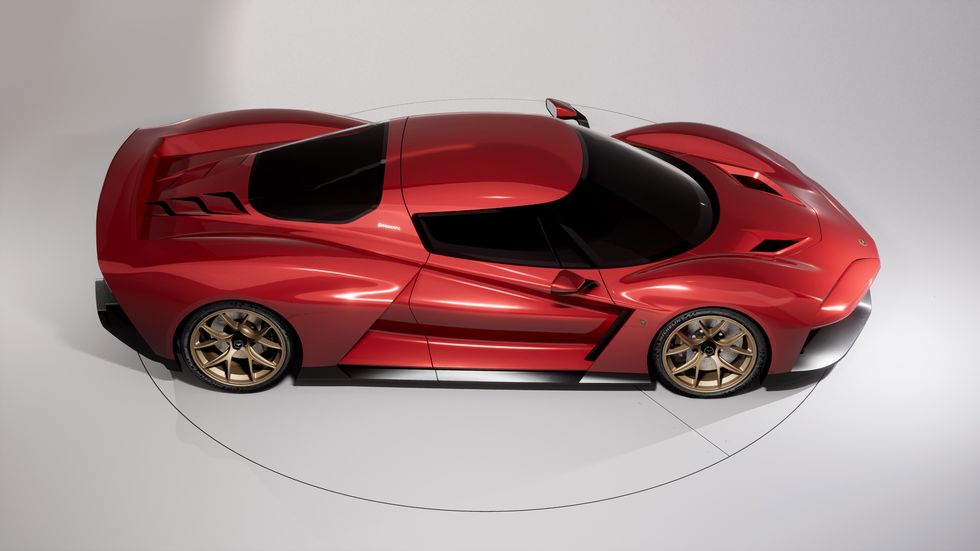- Bizzarrini just released four new photos of its Giotto HyperGT, scheduled to arrive in showrooms around the world in 2026, including in the U.S.
- The carbon-fiber supercar was designed by the Giugiaros.
- No pricing nor any horsepower or torque figures were released.
Supercars come and supercars go, many before ever being made. The Bizzarrini Giotto has all the qualities schoolboys love in a supercar: fabulous carbon-fiber body with lots of wings and flaps, mid-mounted V12 power, and genuine Italian heritage.
It’s just not clear whether the exciting structure you see here actually exists in three dimensions or only in the two dimensions shown above and in the gallery. We asked; haven’t heard back yet.
Regardless, the company has created, even if it’s only on paper, a car that sounds promising. Leading the promise is a deal with Cosworth for a naturally aspirated 6.2-liter V12.
Cosworth has done some of the greatest engines in sports car and racing history, most notably the Ford Cosworth DFV that dominated Formula 1 for years. Most recently Cosworth did and is doing the 3.3-liter V12 in the Gordon Murray T.50 and T.33 supercars, and some of those are actually running, so that part sounds legit.
The Bizzarrini people say the custom-made-mill will “meet all worldwide legislative and emission regulations and is being engineered to deliver ultimate engagement and drivability.” So that means it’ll work here in the U.S.
The specific displacement of the engine is 6626 ccs, which corresponds to Bizzarrini’s birthdate of June 6, 1926. Was that necessary? Why not?
No horsepower or torque figures—0r even goals—were announced. But we do know the engine will sit behind the cockpit, mounted longitudinally and driving the rear wheels. No word on a transmission yet, but we would guess it’ll be a transaxle, mounted aft of the rear axle.
Both the body and chassis of the Giotto will be made from carbon fiber, they say. No word on specifics of the carbon fiber chassis, but the exterior was styled by both Giorgetto and Fabrizio Giugiaro, the father/son team that ran ItalDesign for decades before that entity was bought by Volkswagen. The pair now own GFG Style in Turin, the entity did this car.
The design is supposed to incorporate “a compelling blend of past and present” Bizzarrinis.
“Giorgetto and Fabrizio have captured elements of the most legendary Bizzarrinis of all time and reinterpreted them for the modern era,” the company says.
Do you see all that in the four photos? Bizzarrini says to note “the prominent air vents of the original Bizzarrinis… evolved into a new front visual character,” as well as the ultra slimline LED headlights that converge in the center of the hood and cradle the Bizzarrini badge. From the side it’s supposed to evoke a 5300GT. It’s all aerodynamically efficient, too.
“The Formula One derived dihedral front splitter and rear diffuser combine with the elegant integrated fixed rear wing to ensure appropriate downforce for all driving conditions,” Bizzarrini says.
On-road testing is slated for next year, with the goal being, similar to that of the Gordon Murray T.50 and T.33—not ultimate lap times or acceleration, but what CEO Chris Porritt promises will be “emotional engagement of both the driver and the passenger.”
So far Bizzarrini has delivered around 24 of its 5300GT recreations at $2.4 million apiece. There’s no price yet for the Giotto. But we are looking forward to seeing this “HyperGT” drive by some day, or possibly even to drive one ourselves. For now, enjoy these drawings and promises.
Believe this hypercar will actually see the light of day? Share your thoughts in the comments below.

Mark Vaughn grew up in a Ford family and spent many hours holding a trouble light over a straight-six miraculously fed by a single-barrel carburetor while his father cursed Ford, all its products and everyone who ever worked there. This was his introduction to objective automotive criticism. He started writing for City News Service in Los Angeles, then moved to Europe and became editor of a car magazine called, creatively, Auto. He decided Auto should cover Formula 1, sports prototypes and touring cars—no one stopped him! From there he interviewed with Autoweek at the 1989 Frankfurt motor show and has been with us ever since.
Read the full article here



